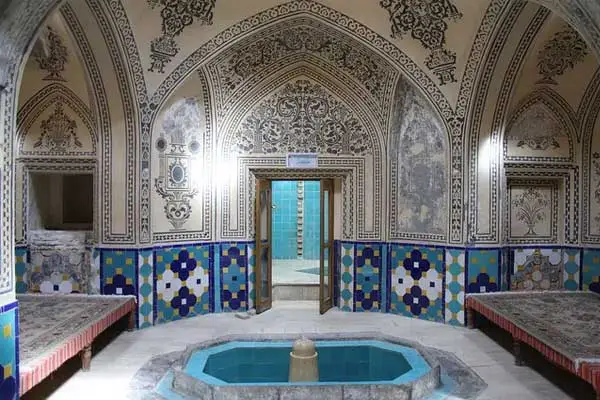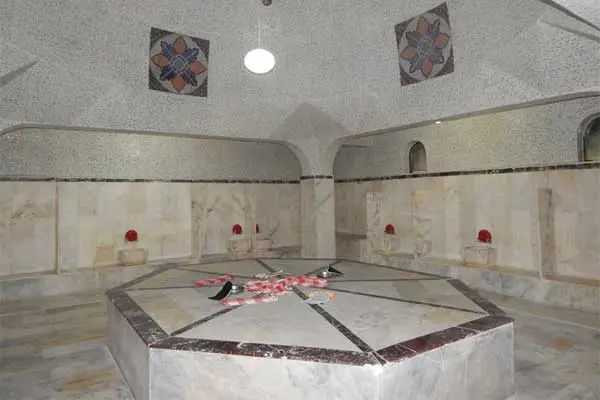The bath, in fact, has been the scene of many Turkish customs and traditions, reflecting the way of life of the Turks. In ancient times, mothers would go to the bathhouse to choose a bride for their son who had reached marriageable age. After selecting a young girl from the bathhouse, they would show her to their son and ask for his opinion. If the girl was also liked by the groom, then the customs related to the proposal of the girl would be carried out.
Wedding ceremonies in Turkey consist of various stages and customs, during which families and both sides of the bride and groom participate. This ceremony is a relaxing and energizing experience in Turkish culture, similar to famous saunas and baths in other parts of the world.
These ceremonies are usually held in a private venue or one of the special Turkish baths, creating a peaceful environment with suitable space for the beauty and makeup of the bride. Before the ceremony begins, the bride prepares for the bath. She wears special clothes chosen for the ceremony and can have her hair, manicure, and pedicure done.
Dowry holds special importance in Turkish culture, and all mothers start collecting dowry for their daughters from childhood. In Anatolia, a small chest is considered as the dowry chest for girls from a young age, and one of the first items placed inside this chest is the bath set. Inside this bath set, items such as a bath bowl, bag, loofah, shampoo, soap, slippers, and towel are placed.
History of Turkish Bath
According to common customs in Anatolia, before holding the henna night ceremony for a young girl, the bride’s bath ceremony is held. Usually, the bride’s bath ceremony takes place on Wednesdays. If the groom’s family has good financial means, they rent the bath for a day, and on this day, only invited guests can enter the bath. In some areas, the bride’s bath ceremony is held by the bride’s mother, and in other areas, it is held by the groom’s mother. Despite the availability of bath supplies in the bride’s dowry, the groom’s side purchases a complete bath set. Inside this bath set, there are towels, a bath bowl, soap, loofah, and slippers. Also, the groom’s side gives slippers to the bride’s relatives and family members. Depending on the taste and financial situation of the host of the bride’s bath ceremony, guests are usually invited by sending gifts such as small towels and soap to the bath. Those responsible for inviting guests go door to door, inviting relatives, neighbors, friends, and acquaintances to the bride’s bath ceremony.
The day the bride’s bath ceremony is to be held is a very exciting and busy day for both the groom’s family and the bride’s family. The groom’s family prepares fruits, sweets, and syrup, which are to be served to the guests, and takes them to the bath. The bride’s mother stands at the entrance to the bath and welcomes the guests who come to the bath. The bride comes to the bath with her friends. After all the guests arrive, the bride, while being surrounded by slippers gifted by the groom’s family, is placed on a stool in the middle of the bath.
The bride’s friends, along with the music group invited to the bath, start playing drums and singing local poems and songs. Guests also join in the singing and dancing. After dancing and singing, it’s the bride’s turn to take a bath. While the bride is bathing, the groom’s mother sprinkles money over her head. In some areas, henna is also applied to the bride’s hands and feet in the bath. Before guests start bathing, the fruits, sweets, and syrup brought by the groom’s family to the bath are placed on a large stone placed in the middle of the bath, and guests are entertained with them. Guests both bathe and celebrate. At the end of the ceremony, the bride’s and groom’s mothers bid farewell to the guests.
In some areas, after the bride’s bath, it is the groom’s turn to take a bath. The groom goes to the bath with his friends, family, relatives, and neighbors. The customs and traditions of the groom’s bath are similar to those of the bride’s bath. Guests of the groom’s bath also both bathe and celebrate. After the groom’s bath is finished, the groom, along with his friends and family, starts dancing and wandering through the streets of the city with the sound of drums and tambourines.
Mary Montagu, the wife of Sir Edward Wortley Montagu, the British ambassador to the Ottoman Empire in the 18th century, participated in one of the bridal bath ceremonies in Istanbul and describes her memories of this bath as follows: The bride, adorned with a silk veil and beautiful gold and jewelry around her neck and ears, enters the bath accompanied by her friends. The group of young people, most of whom are the bride’s friends, start singing and celebrating inside the bath. Also, small gifts are given to the bride by the groom’s mother and some of the guests.
In some Anatolian regions, a week or a day after the wedding night, another bath ceremony called “washing the veil” is held. This ceremony, organized by the groom’s stepmother, is actually the first bath of the bride after the wedding night. Relatives, friends, and relatives of the bride are invited to this ceremony. Also, the bride’s mother buys a gift for her daughter and brings it to the bath. In this ceremony, the newlywed bride hosts the guests.
In Anatolia, in addition to the bridal bath, there are other different customs and traditions related to bathing. Circumcision baths, zao baths, and mourning baths are among these ceremonies. For example, 40 days after childbirth, the zao bath woman goes to the bath with her family and friends, both bathing and celebrating. Circumcision baths are also held before circumcising boys. In some areas, a mourning bath is held for someone who has lost a loved one. Friends and relatives gather the person and take them to the bath. This act symbolizes removing grief and sorrow from the person.
All of these customs and traditions have been common in various parts of Anatolia with slight differences over the years. Today, they have largely been forgotten, especially in big cities. However, in some cases, even in big cities, bridal bath ceremonies are held in their modern form and planned by large catering companies.
The bride, along with her family and friends, goes to the bath and is then transferred to a private room for bathing and makeup. When the bride enters the Turkish bath and goes to a room decorated for her, she cleans and beautifies her skin using soap and special loofahs by professionals. Some baths also offer additional services such as massages, which the bride can use if desired. In addition to bathing and massages, facial and hair masks and other beauty services are also provided for the bride. After the Turkish bath, the bride gets ready and does her makeup. Usually, a very chic makeup look is chosen for the bride, and after the bath and makeup ceremony, the bride goes to the reception and celebration ceremony. Here, music, dance, and joy are usually part of the ceremony.
The Turkish bath ceremony is a great opportunity to take photos and create beautiful memories for the bride and her family and can be a beautiful and relaxing experience for a wedding in Turkey, considered as one of the important wedding events related to makeup and beauty.
The Ramarossi collection assures you that if you request the execution of a bridal bath ceremony in the best place and in a luxurious manner, it will be responsible for your bridal bath ceremony.
FAQs
What cultural significance does the Turkish bath ceremony hold in Turkey?
The Turkish bath ceremony holds deep cultural significance in Turkey, representing purification, beauty, and the transition into married life. It embodies centuries-old traditions and customs, reflecting the essence of Turkish culture and heritage.
Where are Turkish bath ceremonies typically held, and what atmosphere do they create?
Turkish bath ceremonies are usually held in private venues or specialized bathhouses, providing a tranquil and serene environment conducive to the bride’s preparations. These spaces are designed to offer relaxation and beauty enhancement, ensuring a memorable experience for the bride.
What are the preparations involved for the bride before the bath ceremony?
Before the ceremony, the bride undergoes meticulous preparations to enhance her appearance. She selects special attire for the occasion and may avail herself of grooming services such as hairstyling, manicure, and pedicure to ensure she looks her best for the event.
What items typically constitute the bride’s bath set, and what is their significance?
The bride’s bath set, an integral part of her dowry, includes essential items symbolizing her readiness for married life. These items commonly include towels, a bath bowl, soap, loofah, shampoo, slippers, and towels, each carrying symbolic importance in Turkish culture.
Can you describe the sequence of events and traditions observed during the bath ceremony?
The bath ceremony unfolds with the bride’s entry into the bath, accompanied by her friends amidst traditional singing and dancing. Symbolic gestures such as the sprinkling of money by the groom’s mother and, in some regions, the application of henna, mark significant moments during the ceremony. Guests partake in bathing rituals and festivities, contributing to the joyous atmosphere of the occasion.


